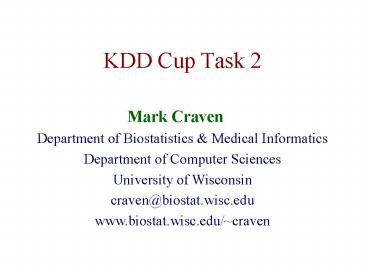KDD Cup Task 2 - PowerPoint PPT Presentation
1 / 13
Title:
KDD Cup Task 2
Description:
... 'reporter' system when each of ~5k genes is knocked out ... 5k strains of yeast, each with a specified gene knocked out) for each strain ... lights up ... – PowerPoint PPT presentation
Number of Views:248
Avg rating:3.0/5.0
Title: KDD Cup Task 2
1
KDD Cup Task 2
Mark Craven Department of Biostatistics
Medical Informatics Department of Computer
Sciences University of Wisconsin
craven_at_biostat.wisc.edu www.biostat.wisc.edu/cra
ven
2
Task Motivation
- molecular biology has entered a new era in which
experimentation can be done in a high-throughput
manner - microarrays can simultaneously measure the
activity of thousands of genes under some set
of conditions - yeast deletion arrays can measure the activity of
some reporter system when each of 5k genes is
knocked out
- key problem it is difficult for biologists to
assimilate and interpret thousands of
measurements per experiment
3
The Problem Domain Characterizing the
Regulatome of the AHR Signaling Pathway
- experimental data kindly provided by
- Guang Yao and Prof. Chris Bradfield
- McArdle Laboratory for Cancer Research
- University of Wisconsin
- the Aryl Hydrocarbon Receptor (AHR) is a member
of the protein family that mediates the
biological response to dioxin, hypoxia, circadian
rhythm, etc. - focus of project determine which proteins affect
the activity of AHR
4
The AHR Signaling Pathway
- when a cell is exposed to say, dioxin, AHR acts
to turn on/off various genes - experiment motivation which proteins (gene
products) in the cell regulate how AHR does this?
5
Characterizing the Regulatome of the AHR
Signaling Pathway
- a high-throughput experiment using the Yeast
Deletion Array (5k strains of yeast, each with a
specified gene knocked out) - for each strain
- insert a specially engineered AHR gene
- insert a reporter system that is activated by
AHR signaling - prod the AHR signaling pathway with a dose of
agonist - see if the reporter lights up
- result we can see which genes encode proteins
that affect AHR signaling
6
The KDD Cup Task
- key computational task help annotate/explain
the results of the experiment, using available
data sources - a proxy task for KDD Cup develop models that can
predict the experimental result for a given gene
from available data sources - rationale
- annotation/explanation task not amenable to
objective evaluation - prediction task, like annotation/explanation
task, involves eliciting patterns from available
data that explain why individual genes behave as
they do in the experiment
7
The KDD Cup Task
- given data describing a gene
- hierarchical (functional/localization annotation)
- relational (protein-protein interactions)
- text (scientific abstracts from MEDLINE)
- do predict if knocking out the gene will have a
significant effect on AHR signaling
8
Characteristics of the Problem
- rich data sources
- much missing data
- function/localization annotations
- protein-protein interactions
- abstracts
- few positive instances (127 pos, 4380 neg)
- very disjunctive
9
Task Evaluation
- evaluated as a two-class problem
- positive knockout has significant effect on AHR
signaling - but two different definitions of positive class
- narrow knockout has an AHR-specific effect
- broad knockout also affects a control pathway
- the scoring metric was the sum of the area under
the ROC curve (AROC) for the two class partitions
10
AROC Scores for All Teams
11
Task 2 Winning Teams
- winner
- Adam Kowalczyk and Bhavani Raskutti
Telstra Research Laboratories - honorable mention
- David Vogel and Randy Axelrod
A.I. Insight Inc. and Sentara
Healthcare - Marcus Denecke, Mark-A. Krogel, Marco Landwehr
and Tobias Scheffer
Magdeburg University - George Forman
Hewlett Packard Labs - Amal Perera, Bill Jockheck, Willy Valdivia
Granda, Anne Denton, Pratap Kotala and William
Perrizo North Dakota State University
12
Current and Future Activity
- figure out what lessons have been learned
- value of text?
- which algorithms learned most accurate models?
- etc.
- determine if learned models can provide insight
into the domain - write articles (task overview, descriptions of
winning teams methods) for SIGKDD Explorations - maintain public access to data set (do Google
search on KDD Cup)
13
Acknowledgements
- the experimental data was generated by
- Guang Yao and Prof. Chris Bradfield
- McArdle Laboratory for Cancer Research
- University of Wisconsin































